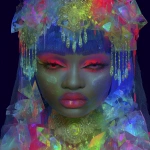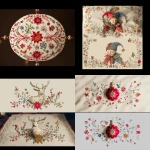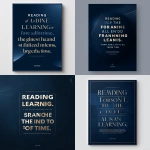Explore the Best AI Image Gallery

The Evolving Canvas: How Wearable Tech is Transforming Creativity
From sculpting sound waves to painting with biometric data, wearable technology is rapidly reshaping the boundaries of artistic expression. This innovative realm blends the physical and digital, empowering creators to interact with their mediums in unprecedented ways.
Wearables are no longer just about fitness tracking or communication; they are becoming powerful tools for artistic exploration. Artists, designers, and musicians are harnessing the capabilities of these devices to push creative boundaries and redefine what it means to create art in the 21st century.
A Palette of Possibilities: Applications Across Creative Fields
The applications of wearable tech in the creative industry are vast and diverse:
- Visual Arts: Augmented reality (AR) glasses and head-mounted displays allow artists to overlay digital elements onto their physical world, creating immersive installations and interactive artworks.
- Music Production: Wearable sensors can capture a musicians movements, biometrics, or even brainwaves, translating them into real-time musical performances. Imagine a composer conducting an orchestra with gestures or a violinist whose emotional state influences the melody.
- Fashion Design: Smart fabrics woven with conductive threads enable clothing that responds to touch, movement, or environmental stimuli, resulting in dynamic and interactive garments that blur the lines between fashion and technology.
- Performing Arts: Wearable LED lights and projection mapping can transform dancers into moving canvases, creating captivating visual narratives. Actors can utilize haptic feedback devices to enhance their physical interactions with the environment and their fellow performers.
Beyond the Tools: Ethical Considerations
As we embrace the transformative potential of wearable tech in creativity, its crucial to address the ethical considerations that arise:
- Data Privacy: Wearables collect vast amounts of personal data. Its essential to ensure transparency and user control over this information, safeguarding against misuse or exploitation.
- Algorithmic Bias: AI algorithms used in creative applications can perpetuate existing societal biases if not carefully designed and monitored. We must strive for inclusivity and fairness in the development and deployment of these technologies.
- Accessibility: The cost and complexity of wearable technology can create barriers to access for certain individuals or communities. Efforts should be made to promote affordability and user-friendliness to ensure equitable participation in this evolving creative landscape.
Looking Ahead: Future Trends in Wearable Creativity
The intersection of wearable tech and creativity is poised for continued evolution:
- Seamless Integration:** Well see increasingly sophisticated integration of wearables with other technologies, such as virtual reality (VR) and the metaverse, creating immersive and interactive creative experiences.
- Personalization: Wearables will empower individuals to tailor their creative tools and workflows to their unique needs and styles, fostering greater self-expression and agency.
- Collective Creation:** Collaborative platforms will leverage wearable technology to enable remote artists and designers to work together in real time, breaking down geographical barriers and fostering global creativity.
The future of creativity is undoubtedly interwoven with the advancements in wearable technology. As these devices become more sophisticated and accessible, they will continue to empower individuals and communities to explore new artistic frontiers, blurring the lines between the physical and digital realms and redefining the very nature of creative expression.

](https://images.ai-img.art/thumbnails/150/6c909fd6d38caac6572b592dd97831deb7d6562bba142798574677582676dfc1.webp)



](https://images.ai-img.art/thumbnails/150/60973df1d727dbbf8e6922b7e4836814ab6012106eb9dcfe99aea7aec15f3710.webp)



](https://images.ai-img.art/thumbnails/150/655229c40961cb7ff5abd4b4190e02c94ea1a961106e7547a562649c945268be.webp)




](https://images.ai-img.art/thumbnails/150/184b4b030e30be0a6d51b544226cb4cf2271977814d935d3aaa2b7529355b3b7.webp)
](https://images.ai-img.art/thumbnails/150/26c16e4f635deee86633de398088ca98d9bb748d6e7601436b07e882fab236cb.webp)

](https://images.ai-img.art/thumbnails/150/e6a179db327f0374ec327d0fdab48ac1f2dc47123eed103b0a41ed346280d07d.webp)



](https://images.ai-img.art/thumbnails/150/1202074d0d60b08b64d0f91f36468608aaac200a02b721cc8e6d8ec8a908432c.webp)



























